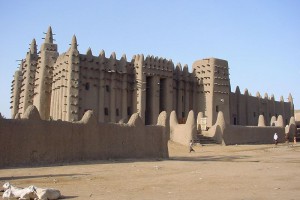For more than two millennia, inhabitants of Djenné, Mali, have lived inside of ancient mud homes, part of a settlement that now contains roughly 2,000 historic structures. The West African town is also home to the world’s largest mud-brick building and one of the finest examples of Sudanese architecture, the Grand Mosque.
But these remarkable World Heritage sites are now in danger of deterioration as rebel groups like al-Qaeda continue to threaten the area, according to UNESCO. The instability means that preservationists are unable to safely work and access materials needed to maintain the ancient structures in the face of erosion and urbanization.
When an UNESCO team visited Djenné earlier this year, they were alarmed to find evidence of deterioration. The organization is working with the Malian government on conserving the elaborate mud buildings, but more financial resources are needed.
A rich cultural and trade center, Djenné’s historical Sudanese-style structures—some of the oldest in existences—are made of mud bricks covered in plaster. Larger important buildings like the Grand Mosque feature wooden beams extending beyond the facade.
curbed.com



